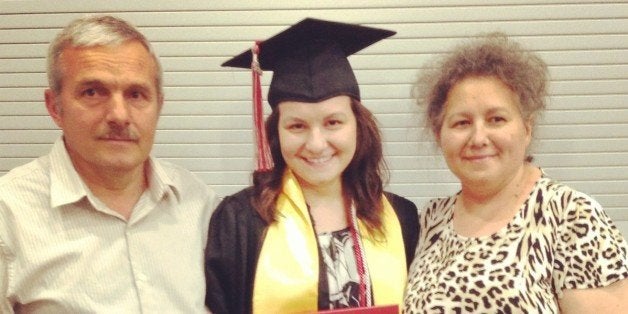
By Yelena Bosovik
How and why did I wind up applying for 100 scholarships to go to college? For me, it was my goal of living the American Dream.
My mom had dreams of being an architect, but instead worked long shifts sewing school uniforms in a factory; back where we came from, my dad worked in commercial construction. Neither of them had gone to college, and they lived a life of religious persecution and hardship under a communist regime in the Ukraine.
Then, in September of 1999, in the hopes of a better future for their children, they packed all their possessions into three bags and, with six kids under the age of eight at the time, sought refuge in the United States.
In my view, my parents are two of the bravest people in the world, because with that sacrifice -- leaving behind family and homeland to move to a foreign country -- they gave me a future.
It just wasn't clear how, exactly, I was going to pay for it. I knew I wanted to go to college and make good on a future that my family risked everything to secure for me, and I knew I had to find a means of financing it.
Today, I am the oldest of 10 children and the first in my family to graduate from college. I attended a small, private liberal arts university in the Midwest with an annual tuition to the tune of $20,000 and graduated in May at the top of my class with a bachelor's degree in finance and economics -- with only $4,500 in student debt. Here's how I did it.
Where I Found the Scholarships
A few facts: My dad was laid off from his delivery job shortly after I graduated from high school, but even before that we lived well below the poverty threshold for a family of our size.
Since my parents could barely make ends meet at home, I knew it was up to me to find the money to pay for college -- tuition, books and other costs like transportation (I didn't get my own car until a few months into my first semester of college) -- while still pitching in for family expenses.
I always joke that scholarship hunting was my second part-time job in high school (I worked weekends at Krispy Kreme). In scheduling for my senior year, I balanced AP classes with easier classes that left me free time during the day to apply for scholarships.
To stay organized, I used a three-inch three-ring binder -- color-coded to keep track of deadlines and different types of scholarships. I also kept a calendar to schedule mailings, due dates and other important milestones.
I proceeded to hound my teachers, mentors and school administrators for letters of recommendation and leads for possible scholarships. And I prayed like crazy, because I was determined to go to my private school of choice and a high price tag wasn't going to daunt me.
The first round of leads came from my school's guidance counselor. As I began mailing out completed applications, I noticed the address on many of them was the same -- a place called the Community Foundation of the Ozarks, which provided opportunities for students in my region.
After getting in touch with the scholarships coordinator at the foundation, I learned that the organization actually had an entire department where they set up and managed funds for corporate and private donors who wanted to donate money for scholarships.
That led me to my second round of applications, as I applied for a variety of scholarships -- diversity, business, first-generation college student, religious and general scholarships. If I met the criteria, then I applied, no matter the amount of the scholarship. I even called a few and negotiated the criteria just so I could apply!
There were a few scholarships that were as low as $250, while the biggest was $10,000 and renewable for up to four years of study.
I thought of it this way -- if I spent an hour filling out an application and got the funding, it would mean I'd made $250, $1,000 or even $10,000 an hour of free money. Not bad!
In my final round of applications, I went to Google and popular scholarship sites like Fastweb to discover a whole spectrum of opportunities -- scholarships for left-handed people or students of a certain height (I applied for one that said you must be below 5'4″).
Most of the applications were very similar, requiring a form with basic background and education information, a few essay questions, letters of recommendation and a transcript.
So I wrote a few essay templates (most had similar prompts like, "Why do you deserve this scholarship?" "What are your career goals?" "What is one event or person who has influenced you?") which I tweaked to fit the requirements of a scholarship. Then, I asked each of my recommenders for dozens of copies of their letters and had my guidance counselor send out my transcript in batches once a month. I was a scholarship application machine!
How Many I Got in the End
I ended up applying for close to 100 scholarships over the course of my college career and received five scholarships my first year, in addition to financial aid from the U.S. Department of Education. I had not only received enough to cover tuition, fees and books for my first year, but I got a hefty refund check to buy a laptop and cover school-related expenses like gas and car insurance (I was a commuter).
Unfortunately, some of the scholarships I received my freshman year were one-time awards and not renewable for my sophomore year. That left me with not enough money to cover tuition my sophomore year.
Going back to my search, I contacted the Community Foundation of the Ozarks again, asking for scholarships for people already in college. I was pleasantly surprised -- there are actually a lot of opportunities for those already enrolled in college, and the requirements are a lot vaguer and easily accessible.
Another great resource is a school's financial-aid employees. For example, I was notified I received a scholarship through the alumni office because I was in the pre-law program. I hadn't applied for the scholarship, but the right people heard through the grapevine that I needed more money for tuition and had recommended me for the award.
The only student loan I took out was to pay for my study abroad program to London the summer after my second year.
What This Money Has Meant to Me
This fall, I start law school. I have a sister starting her second year of college to pursue nursing, and a brother starting his third year in construction management. They're also beneficiaries of generous scholarships.
My 10-year-old sister dreams of being an artist or maybe a police officer. My brother, a senior in high school, is set on a career in business. My other sister wants to be an architect.
My youngest sister can't quite decide yet what she wants to do. But that makes me happy, because I love that I can tell her that indeed, she can be anything she wants to be. No one will deny her college acceptance or send her to prison because of her religious beliefs or economic status.
RELATED: Second-Generation Immigrants Excel
John F. Kennedy once said, "Ask not what your country can do for you -- ask what you can do for your country." I will spend my lifetime trying to give back and pass on the generosity shown to me by this country and its citizens.
Words could never explain how grateful I am for the people, organizations and foundations that have supported my education. I have been incredibly blessed, and I will strive to grasp every opportunity and work hard to make my parents' sacrifices worth the years of underemployment, poverty and prayers.
This is my American Dream, and I'm living it one day at a time.
RELATED: 5 Myths About Poverty, Debunked
Yelena Bosovik is the founder of Lovely Thoughts, a blog for Christian twentysomethings. She has a B.A. in Business Administration from Drury University in Missouri and will start law school this fall at the University of Missouri, Columbia. One day, she'll run for a seat in the U.S. Senate. Follow her on Twitter: @YelenaBosovik.
More From LearnVest
